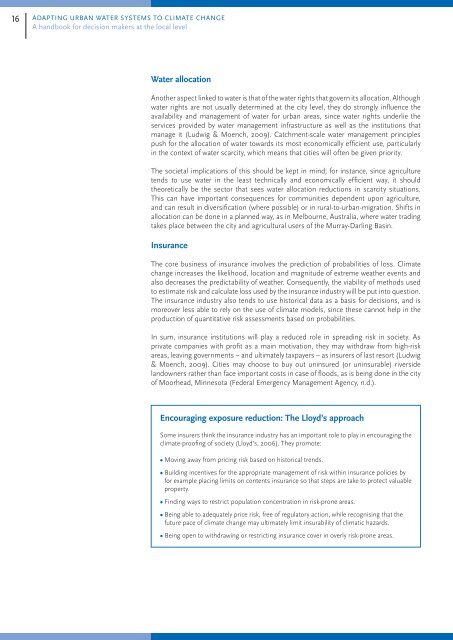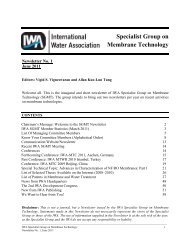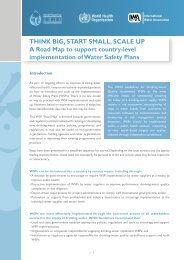AdApting urbAn wAter systems to climAte chAnge - IWA
AdApting urbAn wAter systems to climAte chAnge - IWA
AdApting urbAn wAter systems to climAte chAnge - IWA
Create successful ePaper yourself
Turn your PDF publications into a flip-book with our unique Google optimized e-Paper software.
16 Adapting urban water <strong>systems</strong> <strong>to</strong> climate change<br />
A handbook for decision makers at the local level<br />
Section 1<br />
Vulnerability of urban water <strong>systems</strong> in the face of climate change<br />
17<br />
Water allocation<br />
Another aspect linked <strong>to</strong> water is that of the water rights that govern its allocation. Although<br />
water rights are not usually determined at the city level, they do strongly influence the<br />
availability and management of water for urban areas, since water rights underlie the<br />
services provided by water management infrastructure as well as the institutions that<br />
manage it (Ludwig & Moench, 2009). Catchment-scale water management principles<br />
push for the allocation of water <strong>to</strong>wards its most economically efficient use, particularly<br />
in the context of water scarcity, which means that cities will often be given priority.<br />
The societal implications of this should be kept in mind; for instance, since agriculture<br />
tends <strong>to</strong> use water in the least technically and economically efficient way, it should<br />
theoretically be the sec<strong>to</strong>r that sees water allocation reductions in scarcity situations.<br />
This can have important consequences for communities dependent upon agriculture,<br />
and can result in diversification (where possible) or in rural-<strong>to</strong>-urban-migration. Shifts in<br />
allocation can be done in a planned way, as in Melbourne, Australia, where water trading<br />
takes place between the city and agricultural users of the Murray-Darling Basin.<br />
Insurance<br />
The core business of insurance involves the prediction of probabilities of loss. Climate<br />
change increases the likelihood, location and magnitude of extreme weather events and<br />
also decreases the predictability of weather. Consequently, the viability of methods used<br />
<strong>to</strong> estimate risk and calculate loss used by the insurance industry will be put in<strong>to</strong> question.<br />
The insurance industry also tends <strong>to</strong> use his<strong>to</strong>rical data as a basis for decisions, and is<br />
moreover less able <strong>to</strong> rely on the use of climate models, since these cannot help in the<br />
production of quantitative risk assessments based on probabilities.<br />
In sum, insurance institutions will play a reduced role in spreading risk in society. As<br />
private companies with profit as a main motivation, they may withdraw from high-risk<br />
areas, leaving governments – and ultimately taxpayers – as insurers of last resort (Ludwig<br />
& Moench, 2009). Cities may choose <strong>to</strong> buy out uninsured (or uninsurable) riverside<br />
landowners rather than face important costs in case of floods, as is being done in the city<br />
of Moorhead, Minnesota (Federal Emergency Management Agency, n.d.).<br />
Other institutions<br />
Institutions, particularly those at the governmental level, will be affected by climate<br />
change mainly because of the increasing demands for resources and services – such<br />
as health care, energy and emergency response – that climate change will place on<br />
them. They will also have <strong>to</strong> handle the increasing expenditure that dealing with climate<br />
change manifestations can involve. Such costs might have <strong>to</strong> be met through increases<br />
in revenues or decreases in other services, and may place further stress on already<br />
overextended institutions (Wilbanks et al., 2007). These facts strengthen the case for<br />
strategic and integrated planning using flexible and lower-cost options and technologies,<br />
as reviewed in Section 2.<br />
Financing adaptation in cities<br />
A significant proportion of the average costs of adaptation <strong>to</strong> climate change will include<br />
costs linked <strong>to</strong> cities, largely because of the expense required <strong>to</strong> adapt – or build new and<br />
resilient – infrastructure and services. Although exact figures are not yet available, it is clear<br />
that a large amount of additional investment will be needed if adaptation is <strong>to</strong> be seriously<br />
addressed. In addition, many of the costs of adapting cities – particularly upgrading housing<br />
s<strong>to</strong>ck – will be borne by private individuals. Estimates based on the costs of adapting<br />
infrastructure thus do not represent the <strong>to</strong>tal cost of adaptation. At present, the scale of<br />
funding available falls far short of what is needed, and what little exists gives unsatisfac<strong>to</strong>ry<br />
attention <strong>to</strong> urban areas.<br />
While enhancing financial capacity seems <strong>to</strong> play a role in driving current adaptation<br />
responses, it is <strong>to</strong> a lesser degree than could be expected: several cities around the world<br />
have started <strong>to</strong> initiate adaptation, often irrespective of national frameworks being in<br />
place. City networks are also being set up: these can stimulate national policies and act<br />
as a positive example, providing an important venue for the transfer of knowledge and<br />
technology. City networks exchange good practices on a wide range of issues: one example<br />
is Connecting Delta Cities.* Ultimately, the success of adaptation in cities critically depends<br />
on the availability of necessary resources, not only financial and natural, but also linked <strong>to</strong><br />
knowledge, technical capability, institutional resources and targeted <strong>to</strong>ols (Bakker, 2010).<br />
* http://www.rotterdamclimateinitiative.nl/nl/delta_cities_website/home<br />
Encouraging exposure reduction: The Lloyd’s approach<br />
Some insurers think the insurance industry has an important role <strong>to</strong> play in encouraging the<br />
climate-proofing of society (Lloyd’s, 2006). They promote:<br />
• Moving away from pricing risk based on his<strong>to</strong>rical trends.<br />
• Building incentives for the appropriate management of risk within insurance policies by<br />
for example placing limits on contents insurance so that steps are take <strong>to</strong> protect valuable<br />
property.<br />
• Finding ways <strong>to</strong> restrict population concentration in risk-prone areas.<br />
• Being able <strong>to</strong> adequately price risk, free of regula<strong>to</strong>ry action, while recognising that the<br />
future pace of climate change may ultimately limit insurability of climatic hazards.<br />
• Being open <strong>to</strong> withdrawing or restricting insurance cover in overly risk-prone areas.<br />
To conclude Section 1, it can be said that although uncertainty remains regarding<br />
the expected manifestations of climate change, the likely impacts of climate change<br />
on urban water <strong>systems</strong> are important enough that they cannot be ignored by water<br />
managers. Section 2 highlights the importance of applying a planning process that is<br />
based on forecasts and scenarios and is designed <strong>to</strong> deal with uncertainty and changing<br />
conditions.
















